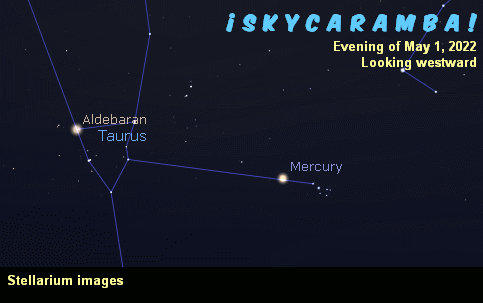The morning “parade of planets” finishes April with Jupiter and Saturn very close. They’re as close as 0.2° at about 21 hours UT on the 30th. The best views are from about 105° east longitude. Too far east of there, and the closest conjunction hasn’t happened yet before the sun rises. Too far west of there, and it has already happened with Venus passing Jupiter. Don’t let being at other longitudes bother you. The view is still splendid. The pair are near one of the Pisces fish heads. Mars is west of them in Aquarius. Saturn is farther west at the edge of Capricornus.

Venus speeds toward the sun morning to morning. Jupiter and Mars are also moving eastward. The red planet is faster and will catch up to Jupiter on the 29th. They’ll be 0.6° apart at 10:27UT. The best views will be from about 100° to 130° west longitude. By this late in May, Venus and Saturn will be much farther from Venus and Saturn. Venus will be on the other side of Pisces. Saturn will remain at the edge of Capricornus.
A last quarter moon passes by Saturn on the 22nd. It’s a waning crescent when it passes by Mars and Jupter on the 24th and 25th. The next two mornings, the moon goes from one side of Venus to the other.
For a morning bonus, use binoculars to find the asteroid Vesta moving near Saturn. They’re closest on the 7th.

In the evening sky, May starts with Mercury between the Pleiades and the Hyades. It’s closer to the Pleiades. The waxing crescent moon is in the neighborhood on the 2nd. That’s an important cue for southern hemisphere observers to find the planet in the sunset’s afterglow. The planet’s disappearing fast. The messenger planet keeps moving eastward, but that part of the sky is sunset-bound. So Mercury is setting sooner after sunset. About a third of the way into the month, Mercury’s not seen in the northern hemisphere either.
Mercury goes through inferior conjunction on the 21st. In a few weeks, it will emerge into the morning sky.
The moon passes by Aldebaran on the 3rd, Pollux on the 6th, Regulus on the 9th, Spica on the 14th, and Antares on the 17th.

One of the most noteworthy events of this month is the total lunar eclipse on the 16th. Most of Africa gets a view of the total phase’s start. Maximum eclipse is visible from northwest Africa, the Atlantic, and most of the Americas. As the earth turns, more of the Pacific gets to see the total phase as it approaches its end. Most of the Americas, the Atlantic, and a the west coast of northern Africa get to see the end. This eclipse will begin on the evening of the 15th in some of the western time zones. In Universal Time, penumbral phase starts at 01:32, partial at 02:28, and total at 03:29. Maximum eclipse is at 04:13. Totality ends at 04:54, partial phase at 05:55, and penumbral phase at 06:51.
The Eta Aquiariids meteor shower peaks on Thursday and Friday the 5th and 6th. You might see 50 to 60 meteors per hour. Best viewing is in the morning darkness. They move fast and often leave trails that glow for a few seconds. The dust that produces them comes from Comet Halley. The comet goes through aphelion, its farthest distance from the sun, next year. But that doesn’t mean the meteor shower will be a washout. If Earth passes through a dense part of an old comet trail, we could be in for a good show.
